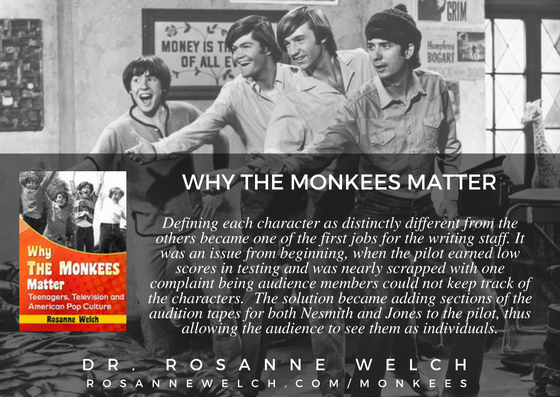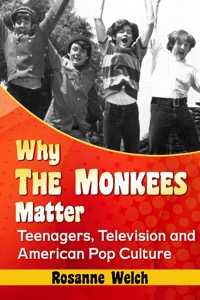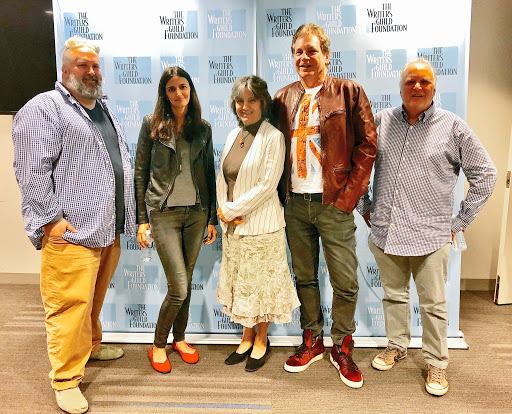Stephens College’s Citizen Jane Film Festival #cjff2017 #stephenscollege via Instagram
Setting up the Studio for pitch sessions, game show and papers from Stephens MFA students on early female Screenwriters. via Instagram
Setting up the Studio for pitch sessions, game show and papers from Stephens MFA students on early female Screenwriters. via Instagram
Good Morning, Columbia, MO via Instagram
A chilly start today to Stephens College’s Citizen Jane Film Festival. 40° This morning. CJ Film School all day today including presentations by Stephens College MFA in Screenwriting Students!
#cjff2017 #stephenscollege #movies #film #education via Instagram
Reading scripts on our flight from LA. Work. Work. Work. via Instagram
Quotes from “Why The Monkees Matter” by Dr. Rosanne Welch – 78 in a series – Pilot
** Buy “Why The Monkees Matter” Today **
Defining each character as distinctly different from the others became one of the first jobs for the writing staff. It was an issue from beginning, when the pilot earned low scores in testing and was nearly scrapped with one complaint being audience members could not keep track of the characters. The solution became adding sections of the audition tapes for both Nesmith and Jones to the pilot, thus allowing the audience to see them as individuals.
from Why The Monkees Mattered by Dr. Rosanne Welch — Buy your Copy today!
Why The Monkees Matter: Teenagers, Television and American Pop Culture
McFarland (Direct from Publisher) | Amazon | Kindle Edition | Nook Edition
A History of Screenwriting – 43 in a series – Body and Soul – Oscar Micheaux (1925)
A History of Screenwriting – 43 in a series – Body and Soul – Oscar Micheaux (1925)
Oscar Devereaux Micheaux (US: /ˈɒskə.mɪˈʃoʊ/ ( listen); January 2, 1884 – March 25, 1951) was an African American author, film director and independent producer of more than 44 films. Although the short-lived Lincoln Motion Picture Company was the first movie company owned and controlled by black filmmakers,[1] Micheaux is regarded as the first major African-American feature filmmaker, a prominent producer of race film, and has been described as “the most successful African-American filmmaker of the first half of the 20th century”.[2] He produced both silent films and sound films when the industry changed to incorporate speaking actors.
Micheaux’s first novel The Conquest was adapted to film and re-titled The Homesteader.[5] This film, which met with critical and commercial success, was released in 1919. It revolves around a man named Jean Baptiste, called the Homesteader, who falls in love with many white women but resists marrying one out of his loyalty to his race. Baptiste sacrifices love to be a key symbol for his fellow African Americans. He looks for love among his own people and marries an African-American woman. Relations between them deteriorate. Eventually, Baptiste is not allowed to see his wife. She kills her father for keeping them apart and commits suicide. Baptiste is accused of the crime, but is ultimately cleared. An old love helps him through his troubles. After he learns that she is a mulatto and thus part African, they marry. This film deals extensively with race relationships.
Director:Oscar Micheaux
Writers:Oscar Micheaux (novel)
Oscar Micheaux (screenplay)
Paul Robeson … Reverend Isaiah T. Jenkins / His brother Sylvester
Mercedes Gilbert … Isabelle – the Girl Julia
Theresa Russell … Martha Jane – Her Mother
Lawrence Chenault … Yello-Curley’ Hinds – the Phony Reverends Former JailmateA minister is malevolent and sinister behind his righteous facade. He consorts with, and later extorts from, the owner of a gambling house, and betrays an honest girl, eventually driving them both to ruin.
Trivia
The board censors initially had strong objections to the dark and sinister portrayal of a man of the cloth. But with no money left for reshoots, producer Oscar Micheaux shot a quick ending which makes most of the film’s action a dream of the heroine’s.
Film debut of Paul Robeson.— Wikipedia
Learn more about Oscar Micheaux with these books
* A portion of each sale from Amazon.com directly supports our blogs *
* Many of these books may be available from your local library. Check it out!
I teach several classes for the Stephens College Low-Residency MFA in Screenwriting, including History of Screenwriting. In fact, I created the curriculum for that course from scratch and customized it to this particular MFA in that it covers ‘Screenwriting’ (not directors) and even more specifically, the class has a female-centric focus. As part History of Screenwriting I, the first course in the four-class series, we focus on the early women screenwriters of the silent film era who male historians have, for the most part, quietly forgotten in their books. In this series, I share with you some of the screenwriters and films that should be part of any screenwriters education. I believe that in order to become a great screenwriter, you need to understand the deep history of screenwriting and the amazing people who created the career. — Dr. Rosanne Welch
24: Writers, Actors and The Monkees : “Why The Monkees Matter” Interview with Jean Power [Video] (0:57)
Rosanne Welch talks about “Why The Monkees Matter” with Jean Hopkins Power
Watch this entire presentation (45 mins)
Jean Powergirl takes the host reigns and welcomes her guest Rosanne Welch, PhD to the show! They’ll be discussing Roseanne’s book, “Why The Monkees Matter: Teenagers, Television and American Pop Culture.”
Transcript:
Rosanne: So, I originally wrote about that and that’s how I got to talk with Micky because I knew, as a child actor, he would understand how one worked with writers and, of course, he always did credit the writers — both the songwriters and the show writers when he was doing his interviews. I did get to talk to him and the secret — which isn’t much of a secret — because I put it in the preface to the book — is that he had been my favorite Monkee so to actually talk to him was the big deal. Even at the age of 50 for god’s sake.
Jean: So she got to talk to her favorite Monkee and was he able to give you some insight?
Rosanne: He was. I mean he, of course, he took seriously the work of the writers and, as an actor, you’ll notice that while they did a lot of ad lib — actors can’t do as much improv as we assume because camera angles have to be created by the directors and they’re based on the script.
Jean:…and isn’t there a tight time and money is time, right
Rosanne: Yes. Because of all the crazy quick shots, this show would do sometimes 60 or 70 camera setups a day when 20 is normal.
A hit television show about a fictitious rock band, The Monkees (1966-1968) earned two Emmys–Outstanding Comedy Series and Outstanding Directorial Achievement in Comedy. Capitalizing on the show’s success, the actual band formed by the actors, at their peak, sold more albums than The Beatles and The Rolling Stones combined and set the stage for other musical TV characters from The Partridge Family to Hannah Montana. In the late 1980s, the Monkees began a series of reunion tours that continued into their 50th anniversary.
This book tells the story of The Monkees and how the show changed television, introducing a new generation to the fourth-wall-breaking slapstick created by Laurel and Hardy and the Marx Brothers. Its creators contributed to the innovative film and television of 1970s with projects like Bob & Carol & Ted & Alice, The Mary Tyler Moore Show, Laugh-In and Welcome Back, Kotter. Immense profits from the show, its music and its merchandising funded the producers’ move into films such as Head, Easy Rider and Five Easy Pieces.
Rosanne Welch, PhD has written for television (Touched by an Angel, Picket Fences) and print (Three Ring Circus: How Real Couples Balance Marriage, Work and Kids and The Encyclopedia of Women in Aviation and Space). In the documentary world she has written and produced Bill Clinton and the Boys Nation Class of 1963 for ABC NEWS/Nightline and consulted on PBS’s A Prince Among Slaves, the story of a prince from West Africa who was enslaved in the 1780s, freed by order of President John Quincy Adams in the 1820s and returned to his homeland.
Podcast: Play in new window | Download
Subscribe: RSS
From The Research Vault: The Monkees: Still monkeying around and inspiring others to play their songs, Washington Post
Dr. Rosanne Welch Moderates “Freaks, Geeks, And Queen Bees: Crafting The Teenage Voice For TV” [Photos]
Such a fun night last night with a wonderfully engaged and energized panel of showrunners talking about Writing the Teen Voice. From top clockwise: Peter Barsocchini (High School Musical), Robia Rashid (Atypical), Chuck Rosin (Beverly Hills, 90210) and Brian Yorkey (13 Reasons Why). Watch their shows!
Photo: Stephens College MFA in TV and Screenwriting
Photo: Writers Guild Foundation












![24: Writers, Actors and The Monkees : “Why The Monkees Matter” Interview with Jean Power [Video] (0:57)](https://rosannewelch.com/wp-content/uploads/2017/10/rmw-power-24-writers-actors.jpeg)


![Dr. Rosanne Welch Moderates “Freaks, Geeks, And Queen Bees: Crafting The Teenage Voice For TV” [Photos]](https://rosannewelch.com/wp-content/uploads/2017/10/wga-panel-1.jpg)
